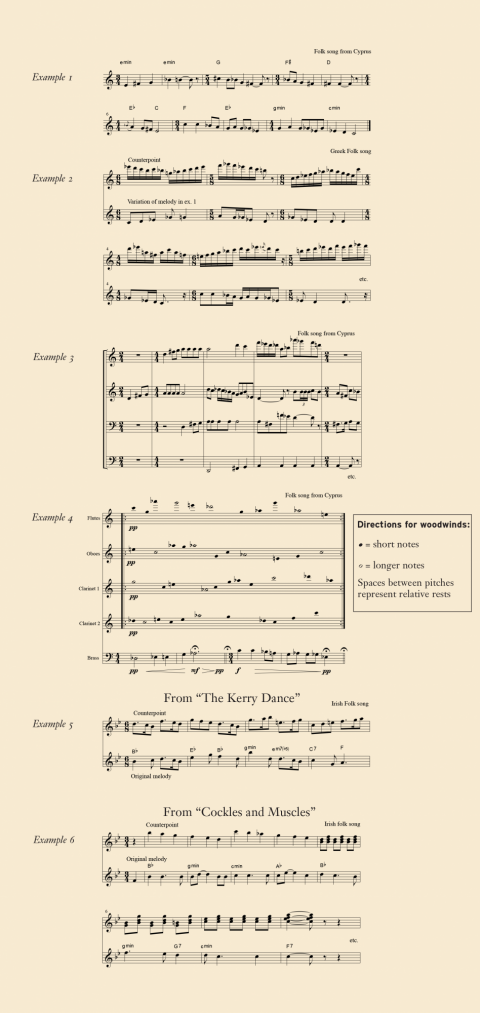Using Folk Songs in Compositions
Thomas J, McGab is a professor in Berklee's Composition Department. McGab's music has been performed in the United States, Canada and Greece where McGab resided for a year before began teaching at Berklee
Folk music or traditional music is the “music of the earth.” It arises out of an innate human need to express the joys and sorrows of life common to all people. This genre has historically been the product of untrained musicians (the folk) and its individual songs vary from being very simple to quite complex melodically, harmonically, and rhythmically. For centuries, composers have used folk melodies thematically in new works. Liszt, Grieg, Vaughan Williams, Stravinsky, Delius, Bartok, Copland, Enesco, and Grainger are prominent among those who employed this practice. In particular, Bartok, through his original compositions and pioneering research in folk music, served as a model for the integration of folk music into musical compositions.
Over the past nine years, I have had opportunities to compose two large compositions for concert band that utilized folk music melodies. Four Fantasias on Greek Folk Songs was composed for and premiered by the MIT Concert Band with Music Director John D. Corley, and Suite of Irish Folk Songs was composed for and premiered by the Concord, Massachusetts, concert band under the baton of Dr. William G. McManus.
A composer who intends to employ a folk song or a dance in a composition is confronted with a musical problem. If the folk melody is monophonic (consisting of only a melody), as is often the case, the composer must decide what type of harmonic accompaniment will fit best. He or she must determine whether to use simple, diatonic, chromatic, or “modern” structures and whether that harmonic approach will complement and add to the beauty of the melody or detract from it.
After searching through collections of folksongs, first Greek and later Irish ones, I selected melodies that appealed to me and that seemed to offer a variety of possible musical settings or treatments. In planning these works, I decided not to arrange the folk songs, but rather to incorporate them into and around my original music. I wanted the integrity of the songs to be preserved, and my original music to complement the folk melodies rather than create an incongruous contrast. I felt that the spirit of the folk songs should be foremost in these compositions.
Because all the Greek songs I chose were monophonic, I had some latitude with regard to harmonization, and because all of the melodies were modal, an obvious choice was to make the harmony modal as well (see ex. 1). This allowed me the freedom to avoid tonal, functional chord relationships. That flexibility offered me a wider choice of chords, and, to some extent, it imbued the music with a somewhat archaic quality.
After working out a number of different harmonizations for the melodies, I began to explore various contrapuntal possibilities. I wrote counterpoints against the folk song melodies and then proceeded to write variations of the folk songs themselves, slightly changing some of the rhythms and intervals in the process. Next, I wrote new counterpoints to those variations (see ex. 2). Then I explored the stretto possibilities of the folk songs. The Italian term “stretto” means “narrow” or “close.” In music, it describes the contrapuntal device found in fugues where the subject is played against itself as a canon (see ex. 3). Needless to say, even though I discovered a number of possibilities, not all of them were musically effective. Some seemed too contrived.
Lastly, I considered the overall character or mood of each song, and planned a sequence in which the songs should be played, considering carefully which song should be first and which should be last. Mindful that it is advisable to begin and end with something lively, I chose the following tempo scheme for the work’s four movements: fast, slow, moderate, fast.
In the second song of my Four Fantasias on Greek Folk Songs, I introduce an aleatoric (improvisatory) section by giving the players of the higher-pitched woodwind instruments (flutes, oboes, and clarinets) a choice of pitches to play in any rhythm they wish while the low brass (trombones, baritone horn, and tuba) play different phrases of the main melody. This creates a bird-like, chirping texture (see ex. 4).
In composing the Suite of Irish Folk Songs, some aspects of the process were the same as those I encountered in treating the Greek folk songs, but some factors were significantly different. Irish folk songs are familiar to many people—especially in the Boston area. With one exception, they are not monophonic, that means the harmonic flavor of the songs is also familiar. This indicated to me that the harmony needed to be somewhat more conservative than it had been in the four fantasias. Two examples may illustrate this point (see ex. 5 and 6). I selected the following songs for the Suite of Irish Folk Songs: “The Kerry Dance,” “Cockles and Mussels,” “O’Donnell Aboo!” (Onward O’Donnell!), “My Lagan Love,” “Johnny, I Hardly Knew Ye” (also known as “When Johnny Comes Marching Home”). The tempo scheme for the suite’s movements is fast, slow, fast, slow, fast.
I am pleased that each work has received a number of performances and I am especially pleased that my acquaintances of Greek and Irish descent have expressed their compliments about the music. I am assuming that my aim to preserve the spirit and integrity of the folk songs integrated into my music has been accomplished.





